The rural town of Llanybydder lies on the A485 main road from Carmarthen to Lampeter. The war memorial in Llanybydder is sited on the cross-road in the centre of the village, alongside the main road. Fifteen men and one woman are commemorated on the war memorial, and the names seem to be in no particular order with WW1 and WW2 mixed. Below are the details of these people, plus any others with links to the village, who are not commemorated on the war memorial. None of these names on the memorial has any useful details for identifying them apart from the age and address, which makes research a bit more difficult than normal, however, after much head scratching, the following Roll of Honour for Llanybydder is as accurate as is possible at the moment. Any additional information is always welcome.
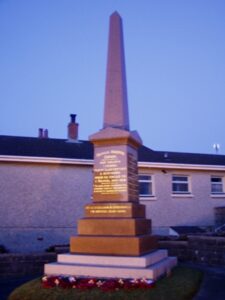
The Great War, 1914-1918
Isaac Davies, Private, 33756, Welsh Regiment. Isaac was born in 1884, the son of Isaac Davies and Anne Davies (nee Jones), of Blaenina, Llanybydder. He left home to find work as a coal miner as a young man and by 1911 was lodging with his brother Thomas and his family at Haulybryn, Llandeilo Road, Brynamman. Isaac married Sarah Jones at Brynamman in the spring of 1914 and the couple set up home together at Trehyfryd House, Llandiloe Road, Brynamman, where their daughter Marian was born later that year. Isaac enlisted at Brynamman into the 8th Battalion, Welsh Regiment in the spring of 1915. The battalion was at Aldershot and was the Pioneer Battalion to the 13th (Western) Division. On 13 June 1915 the Division sailed for the Mediterranean, and during July 1915 landed on Cape Helles, relieving the 29th Division, before moving to ANZAC Cove from 3 August 1915, taking part in the Battles of Sari Bair, Russell’s Top, and Hill 60, ANZAC. Soon afterwards the Division was transferred from ANZAC to Suvla Bay, and it was evacuated from Suvla on 19 December 1915, transferring to Helles. On 8 January 1916, the Division was evacuated from Helles, and by 31 January was concentrated at Port Said, where they held forward posts in the Suez Canal defences. On 12 February 1916 the Division began to move to Mesopotamia, to strengthen the force being assembled for the relief of the besieged garrison at Kut al Amara. Isaac took ill soon afterwards and was evacuated via Hospital Ship to Bombay. He died of dysentery in Bombay on 22 August 1916. The 35-year-old was originally buried in Sewri Cemetery, Bombay, but in 1962 the war graves in the cemetery were exhumed and re-interred in Kirkee War Cemetery, India.
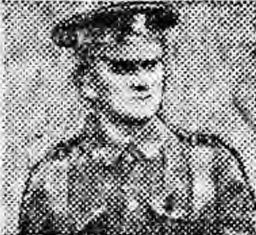
William John Davies, Flight Sergeant, Royal Air Force. William was born in 1888, the son of David Davies and Mary Davies of Gwardwar, Llanybydder. He had left home as a young man and lodged at 9, Hampden Street, Somers Town, London, working first as a milk carrier and then as a clerk. William married Elizabeth Margaret Hamilton Scott in London on 11 December 1912 and the couple moved back to Wales, settling at 26, Station Road, Ystrad Mynach, where their three children were born. William enlisted into the Royal Flying Corps on 21 September 1915 and was posted to the E.P.D. Branch at Chingford. He remained in the services following the merger of the Royal Flying Corps and the Royal Naval Air Service to form the Royal Air Force in March 1918. William contracted tuberculosis during the war and died at the Sanatorium at Hay on Wye on 22 October 1920. The remains of the 33-year-old were brought home and he was buried in Ystrad Mynach Churchyard. William is not commemorated on the Llanybydder war memorial. His eldest son, Adrian David Davies served as a Second Lieutenant during the Second World War and was captured by the Japanese. He survived the war and lived until 2001.
William Thomas Davies, Private, 57772, Welsh Regiment. William was born on 15 December 1899, the son of David Davies and Martha Davies (nee Evans), of Llygadenwyn, Llanybydder. He enlisted into the Pembroke Yeomanry at Carmarthen on 10 August 1915, but was discharged three days later after having been found to have lied about his age. Undeterred, William waited until he turned eighteen and re-enlisted into the Royal Welsh Fusiliers on 17 January 1918 and was posted to Oswestry for training, initially with the South Lancashire Regiment. He then transferred to the Glamorgan Yeomanry and was drafted to France on 16 June 1918, joining the newly arrived 24th Battalion, Welsh Regiment. The battalion had formed in Egypt from the merging of the Pembroke and Glamorgan Yeomanry in March 1917, attached to 231 Brigade, 74th (Yeomanry) Division, and had fought in Palestine before moving to the Western Front in May 1918. The Division trained near Le Cauroy before taking over positions in the St. Floris Sector, moving into the front line between the La Bassée Canal and the River Lys, with the left resting on the small village of Corbie. The Division faced the recently lost town of Merville, some 3,000 yards away. To the south, the Allies launched their offensive on 21 August 1918, and began the great advance towards the Hindenburg Line. The 74th Division was transferred south to the Somme sector join this great offensive and assembled around Beaucourt Chateau. The 24th Welsh remained in reserve at Trigger Wood, before moving into the front line on 6 September, when 231 Brigade relieved 230 Brigade. William was killed in action on the following day, 7 September 1918, during an attack by the Brigade. The 18-year-old is buried in Vadencourt British Cemetery, Maissemy, France.
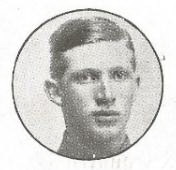
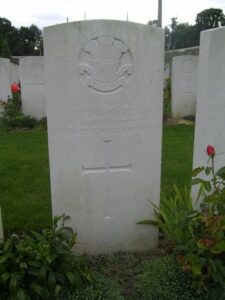
Alfred Evans, Private, 2754, Welsh Guards. Alfred was born at Llanycrwys on 14 June 1894, the son of Jenkin Evans and Rachel Evans (nee Pugh). The family later resided at 14, Rock Terrace, Aberaeron. Alfred was educated at Llanycrwys, before gaining work as an agricultural labourer. He enlisted into the Welsh Guards on 18 May 1916 and was drafted to France in December 1916, joining the 1st Battalion, Welsh Guards at Bronfay Farm. The battalion was attached to attached to the 3rd Guards Brigade, Guards Division and had seen heavy fighting during the Somme offensive during the previous months, and after the Somme offensive had died down, the Guards remained on the Somme for the winter. On 26 December the Welsh Guards moved into the front line between Bouleaux Wood and Haie Wood, to begin a routine tour in the trenches. The usual routines of rotating for duty in the trenches in this same Somme sector continued over the coming weeks, in terrible conditions. Alfred was wounded on 12 March 1917. He returned to action after recovering from his wounds, and fought at the Battle of Cambrai later that year, but was evacuated home to the 4th General Hospital at Denmark Hill, London after being gassed at Cambrai in December 1917. Alfred sadly died of the effects of gas poisoning at Denmark Hill on 20 April 1918. The remains of the 23-year-old were conveyed home and he was buried in Rhydybont Congregational Chapelyard, Llanybydder. Alfred is not commemorated on the Llanybydder war memorial.
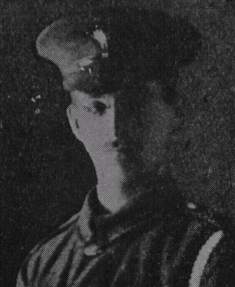
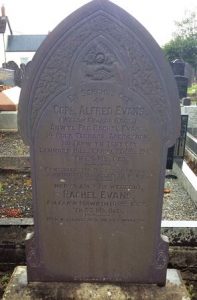
Thomas Davies Evans, Driver, 730701, Royal Field Artillery. Thomas was born in about 1885, the son of Thomas Evans and Sarah Evans (nee Davies), of Green Meadow, Llanybydder. He left home as a young man to work as a draper and by 1911 was lodging at 3, Green Hill, Pontycymmer. He left Pontycymmer soon after to take up a position at Cardiff and in the spring of 1915 married Gwendoline May Nicholas, of Glynteg, Whitchurch, Cardiff. Thomas had already enlisted into the 2nd Welsh Field Battery, Royal Field Artillery soon after the outbreak of war. The battery was attached to the Welsh Division, the sole Welsh front-line Territorial Army Division. In December the Division moved to Cambridge and then in May 1915 to Bedford, where the Division was numbered the 53rd (Welsh) Division. On 19 July 1915 the entire Division sailed from Devonport for Imbros and on 9 August 1915 landed at Suvla Bay. The infantry moved off the beaches across the Salt Lake, under shellfire, into the scrub covered Chocolate Hill, but due to a lack of maps and no knowledge of the terrain, many of the units became disorientated, and the situation became chaotic. After the fighting died down, the winter rolled in, and the men first had to endure torrential downpours, which flooded the trenches, before the snow hit, and many men began falling ill in the terrible conditions. The Division was eventually evacuated from Gallipoli in December 1915, moving to Egypt to join the EEF, and helped guard the Suez Canal before taking part in operations to drive the Turks out of the Sinai. The EEF then turned its attention onto driving the Turks out of Palestine, and on 26 March 1917 launched its first offensive against the coastal city of Gaza, which guarded the road to Jerusalem. Initial gains during the day were lost when the assaulting divisions lost touch with each other and communication broke down when a thick fog cloaked the battlefield. A second attempt to force Gaza was launched on 17 April, which also failed, and the EEF suffered a change in leadership, with Sir Edmund Allenby assuming command, before being re-organised, and a third offensive was launched against a wider front from Beersheba to Gaza on 31 October 1917. This time the Turkish defences were breached, and the road to Jerusalem now lay open and the EEF began to advance north. On 6 November 1917, 158 Brigade launched an attack on the Khuweilfeh Heights, and once secured, the EEF continued its advance into the Judean Hills, the 53rd Division capturing Hebron and Bethlehem, before securing the Jerusalem to Jericho Road. Allenby finally made his triumphant entry into Jerusalem on 11 December. Thomas survived all these terrible battles, but sadly took ill just prior to the Armistice and died of pneumonia in the 27th General Hospital at Abasia, Egypt, on 6 November 1918. The 32-year-old is buried in Cairo War Memorial Cemetery, Egypt.
Garfield Ivor Griffiths, Sapper, 448351, Royal Engineers. Garfield was born at Skewen in 1887. By 1891 he had been fostered by James Jones, a farmer, of Waun, Llanybydder. Garfield trained as a cabinet maker as a young man, then following the outbreak of war enlisted into the Welsh Field Company, Royal Engineers. He was originally posted to the 2/1st Welsh Field Company, which was at Bedford, before being drafted to the Mediterranean on 23 October 1915, joining the 1st Welsh Field Company, which was at Gallipoli attached to the 53rd (Welsh) Division. By the time Garfield landed, the main fighting had died down, but the winter had rolled in, and the men first had to endure torrential downpours, which flooded the trenches, before the snow hit, and many men began falling ill in the terrible conditions. The Division was eventually evacuated from Gallipoli in December 1915, moving to Egypt to join the EEF, and helped guard the Suez Canal before taking part in operations to drive the Turks out of the Sinai. The EEF then turned its attention onto driving the Turks out of Palestine, and on 26 March 1917 launched its first offensive against the coastal city of Gaza, which guarded the road to Jerusalem. Initial gains during the day were lost when the assaulting divisions lost touch with each other and communication broke down when a thick fog cloaked the battlefield. A second attempt to force Gaza was launched on 17 April, which also failed, and the EEF suffered a change in leadership, with Sir Edmund Allenby assuming command, before being re-organised, and a third offensive was launched against a wider front from Beersheba to Gaza on 31 October 1917. This time the Turkish defences were breached, and the road to Jerusalem now lay open and the EEF began to advance north. On 6 November 1917, 158 Brigade launched an attack on the Khuweilfeh Heights, and once secured, the EEF continued its advance into the Judean Hills, the 53rd Division capturing Hebron and Bethlehem, before securing the Jerusalem to Jericho Road. Allenby finally made his triumphant entry into Jerusalem on 11 December. Garfield survived all these terrible battles, but sadly took ill just after the Armistice and died of dysentery on 16 November 1918, aged 31. He is buried in Gaza War Cemetery, Israel.
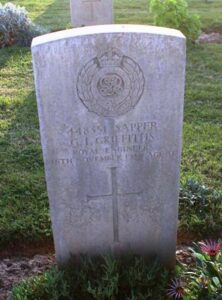
David Hughes, Private, 19019, South Wales Borderers. David was born at Llanfihangel Ystrad in 1880, the son of Daniel Hughes and Margaret Hughes (nee Davies). His father then bought the Highmead Arms at Llanybydder, so the family moved there by 1901. David worked as a stone mason after leaving school. He married Dinah Matilda Evans in 1901 and the couple settled at Tenby Cottage, Llanybydder. The young couple then moved to Ystradgynlais by 1911 and lodged at Wern Ddu, where David worked as a stone mason in a colliery. He enlisted at Ystradgynlais into the 5th Battalion, South Wales Borderers soon after the outbreak of war. The battalion formed at Brecon in September 1914, before moving to Park House Camp, near Tidworth to join 58 Brigade, 19th (Western) Division. In December 1914 the battalion moved to Basingstoke in billets, then on 10 January 1915 became converted to the Pioneer Battalion for the 19th Division. The Division completed its training at Bulford and Perham Down, before embarking for France and landing at Le Havre on 16 July 1915. The entire 19th Division then moved to the Nursery Sector at Calonne for trench initiation alongside the Dehra Dun Brigade. The infantry battalions of the division then began carrying out the usual routines of rotating in the trenches: four days in the front line; four in support; and four in reserve, interspersed with training regimes and carrying out working parties and trench raids. Just south, the British launched a great offensive around the town of Loos on 25 September 1915, and the 19th Division was ordered to attack from its positions at the same time, to attempt to draw enemy attention away from the main battle area. The assault was a disaster, and heavy casualties were suffered by the 19th Division for no gain. The following year the Division moved to the Somme, where it took part in the second wave of the attack on Ovillers-La Boiselle on 1 July, capturing the village at heavy cost. David was seriously wounded during the Battle, and was progressively worked home, through the various Casualty Clearing Stations and Base Hospitals in France, to Bowood Hospital in Wiltshire. He died of septicaemia at Bowood Hospital on 16 September 1916. The remains of the 37-year-old were conveyed home and he was buried in Aberduar Welsh Baptist Chapelyard. One of his brothers, William Walter Hughes, was mentioned in despatches during the war.
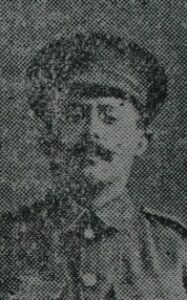
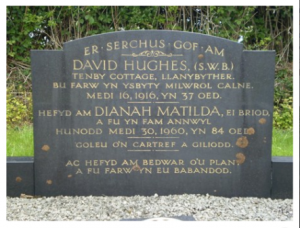
John Jones, Private, 27774, South Wales Borderers. John was born in 1894, the son of Rees Jones and Elizabeth Jones (nee Evans), of Rhiw Bedr, Llanybydder. Following the death of his mother, John was raised by his grandfather, John Jones, at Peter’s Hill, Llanybydder. He joined his father and brother in Garnant prior to the war then enlisted at Seven Sisters into the Brecknockshire Battalion, South Wales Borderers. The battalion was attached to the Welsh Division and moved to Pembroke Dock upon mobilisation. It was then withdrawn from the Division, entraining at Neyland, and on 29 October 1914 sailed from Southampton for Bombay aboard the SS Dilwari, where the battalion transhipped and sailed for Aden, arriving on 16 December 1914. The battalion endured a torrid time in the heat of Aden, losing several men to heatstroke. In August 1915 the battalion moved to India on garrison duties. John then decided he wanted to see some action, so voluntarily transferred to the Devonshire Regiment, embarking for Mesopotamia, but upon disembarking at Basra was posted to the 4th Battalion, South Wales Borderers, which was attached to 40 Brigade, 13th Division. On 8 January 1916, the Division had been evacuated from Helles, and by 31 January was concentrated at Port Said, where they held forward posts in the Suez Canal defences. On 12 February 1916 the Division began to move to Mesopotamia, to strengthen the force being assembled for the relief of the besieged garrison at Kut al Amara, but the relief failed, and Kut fell to the Turks. The Division then took part in the advance through Mesopotamia, which was to successfully liberate the country from 100’s of years of Ottoman rule. John was killed during the fighting for the Hai Salient on 15 February 1917. The 23-year-old has no known grave and is commemorated on the Basra Memorial, Iraq. His brother, Rees Jones, died in Salonika in 1918.
John Rees Jones, Private, 203373, Welsh Regiment. John, known as Rees, was born in Llanybydder in 1883, the son of Rees Jones and Elizabeth Jones (nee Evans), of Rhiw Bedr, Llanybydder. His mother died when he was young and his father moved with Rees and three of his siblings to Maesywernen, Cowell Road, Garnant by 1911, and then moved again to 61, Colbren Road, Gwaun-cae-Gurwen prior to the war. Rees worked there as a stone mason prior to the war. He enlisted at Gwaun-Cae-Gurwen into the 4th Battalion, Welsh Regiment and was posted to Bush Camp at Pembroke for training, before being posted to the 11th Battalion, Welsh Regiment, which was known as the Cardiff Pals battalion, and was attached to 67 Brigade, 22nd Division. In December the battalion moved to St. Leonard’s in billets, then completed its training at Seaford and Aldershot before embarking for France and landed at Boulogne on 6 September 1915. The Division’s stay in France was to be very short, however, as on 27 October 1915 the Division, having been moved by train to Marseilles, began to embark for Salonika as part of an Anglo-French force sent to hold the Greek border, due to the invasion of neighbouring Serbia by a combined Austro-Hungarian force. The Division remained in the Salonika theatre for the rest of the war, taking part in the Retreat from Serbia during December 1915. Large battles were fought in August 1916, at the battle of Horseshoe Hill, then in September 1916 at the battle of Machukovo. Between 24 April and 9 May 1917 the Division fought at the battle of Doiran, and then on 18 September 1918 at the Second Battle of Doiran. Rees was attached to the 67th Battalion Machine Gun Corps at some time during the campaign. He was serving with the battalion when he took ill and died of influenza and pneumonia on 6 October 1918. The 35-year-old is buried in Mikra British Cemetery, Kalamaria. His brother, John Jones, of Llanybydder, was killed in Mesopotamia in 1917.
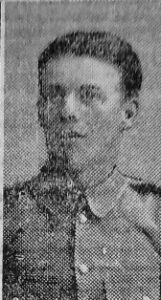
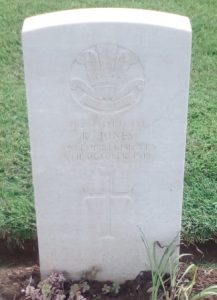
Llewellyn Jones, Private, 39592, South Wales Borderers. Llewellyn was born in 1894, the son of David Jones and Catherine Jones, of Henfaes, Llanybydder. He enlisted at Carmarthen into the 2/1st Battalion, Pembroke Yeomanry soon after the outbreak of war. The battalion had formed in Carmarthen as part of the 2/1st South Wales Mounted Brigade then moved to Llandeilo and again to Dorchester. In September 1915 the brigade moved to the Yoxford area joining the 1st Mounted Division, then in 1916 the brigade became the 4th Mounted Brigade. Llewellyn was drafted to France in September 1916 and was posted to the 2nd Battalion, South Wales Borderers, which was attached to 87 Brigade, 29th Division. The Division had suffered terrible casualties during the opening day of the Somme offensive, taking part in a suicidal assault against Y-Ravine on 1 July 1916, when the 2nd SWB alone suffered some 384 casualties. Although severely depleted, the Division remained in the line here over the coming weeks, in trying conditions before being pulled out of the line and on 27 July entrained at Doullens for the Ypres Salient to rest and rebuild. The division took over the line in front of Wieltje upon its arrival, and this is where Llewellyn joined the 2nd SWB. At the beginning of October the division was relieved and entrained for the Somme again, reaching Amiens by 7 October. Over the coming weeks the division marched in stages back into the battle area, reaching Bernafay Wood by 19 October, where the men bivouacked. After dark the 2nd SWB moved again, marching through the ghostly ruins of Longueval to take up positions near Gueudecourt, to take part in the latter stages of the Somme offensive, during the Battle of Le Transloy and in the early hours of 20 October took up positions in Grease Trench. Llewellyn was killed in action here, possibly by friendly fire, on 21 October 1916. The 22-year-old has no known grave and is commemorated on the Thiepval Memorial, France.
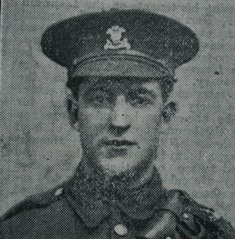
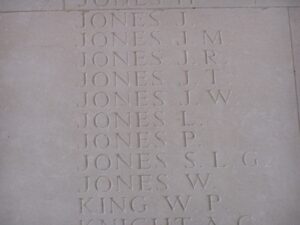
William Jones, Sapper, 113892, Royal Engineers. William was born in 1874, the son of William jones and Eliza Jones (nee Hughes), of Dderwengam, Llanybydder. The family left the town by 1891 and had settled at 3, New Zealand Houses, Rhymney. William worked as a Mason at Pengam prior to marrying Edith Annie Baldwin on 31 October 1897 and the couple had a daughter, Muriel, born the following year. Edith died in 1905 and William remarried Gladys Margaret Rees on 7 July 1912. The couple resided at Tugela House, Elliott’s Town, New Tredegar, where their daughter Elizabeth Irene was born. The name of the house suggests that William was a Boer War Veteran. On 28 September 1915 William enlisted into the Royal Engineers, and was posted to Newark, before being posted to the 157th Field Company, Royal Engineers. The Company was attached to the 16th (Irish) Division, and landed in France on 19 December 1915, and concentrated in the Bethune area with the division before taking over the line in the Mazingarbe Sector. William was wounded at Philosophe by a rifle grenade on 9 April 1916 then recovered in hospital in France, before being posted to the 155th Field Company, in the same 16th (Irish) Division. The division moved to the Somme in August to join the Somme Offensive, taking part in the Battle of Guillemont, and also fought at the Battle of Ginchy. By May 1917 the Division had moved to positions south of Ypres, where it fought at the Battle of Messines on 7 June. The division then moved slightly north, fighting at the Battle of Langemarck. William was wounded in the head by gunfire during this time and was evacuated home via the chain of Field Ambulance to Casualty Clearing Station and Base Hospital to England, before being hospitalised at the Manchester Royal Infirmary. He died of his wounds in hospital at Manchester on 9 September 1917. The 43-year-old was buried in Manchester Southern Cemetery. William is not commemorated at Llanybydder.
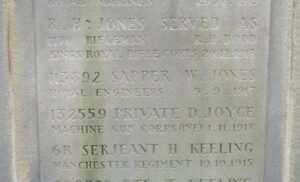
Herbert Gladstone Ridge, Sapper, 915, Royal Engineers. Herbert was born at Manchester in 1886, the son of Alfred Ridge. By 1901 the family was living at Taunton, and it was probably there that Herbert joined the Great Western Railway. By 1911, Herbert was lodging at 1, Alma Road Avenue, Kingston, Bristol, working as a Piano Tuner. Prior to the outbreak of war, Herbert was living at 36, Gilbert Road, Llanelli, and was working for the Great Western Railway, based at Llanybydder. He enlisted at Llanelli on 24 July 1915 into the Welsh Field Company, Royal Engineers, and was posted to the Mediterranean Expeditionary Force, which was in Egypt. After a year on active service in Egypt, Herbert became ill, and returned home on 2 October 1916. He died at Taunton on 18 March 1918, aged 31, and was buried at Taunton (St. Mary’s) Cemetery. Herbert has only recently been accepted for commemoration by the CWGC, following my own research. He is not commemorated on the Llanybydder war memorial.
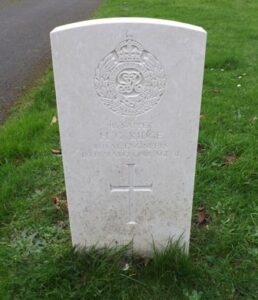
Benjamin James Rodney, Gunner, 30002, Royal Field Artillery. Benjamin was born at Prendergast, Haverfordwest in 1894, the son of Thomas Rodney and Ann Rodney (nee Williams). He worked in the Great Western Railway Station at Llanybydder prior to the war. Benjamin enlisted into the Royal Field Artillery soon after the outbreak of war and was posted to the Depot at Preston. He was then drafted to France on 21 July 1915 and joined an unknown battery of the Royal Field Artillery. Early in 1916, Benjamin was transferred to the newly arrived A Battery, 77th Brigade, Royal Field Artillery, which was attached to the 16th (Irish) Division and was in the Mazingarbe sector. The division moved to the Somme in August to join the Somme Offensive, taking part in the Battle of Guillemont, and then fought at the Battle of Ginchy. By May 1917 the Division had moved to positions south of Ypres, and the 77th Brigade, RFA set up at Hallebast Corner, near Ypres, where it supported the infantry assault of the Battle of Messines on 7 June. The 77th Brigade, RFA then moved its HQ to Chateau des Trois Tours at Brielen, to support the softening up process for the forthcoming assault on the Pilckem Ridge. Benjamin was wounded by German counter-battery fire on 26 July 1917 and was taken to the 64th Casualty Clearing Station at Proven, where he died of his wounds on 29 July 1917. The 23-year-old was buried in Mendinghem Military Cemetery, Belgium. His brother, George Stanley Rodney, was killed in France in 1918.
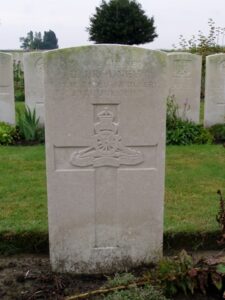
John Vaughan Thomas, Private, R/259428, Royal Army Service Corps. John was born in 1889, the son of Thomas Thomas and Margaret Thomas (nee Jenkins), of Llanybydder. He married Anne Morgans at Lampeter on 22 April 1911 and the couple set up home at Penrock, Llansadwrn, where John had gained work as a wool spinner. He enlisted into the Army Service Corps (Remounts) at Llandeilo on 6 June 1916 and was posted to the Remount Depot at Ormskirk, before embarking for France. John served with the Remounts for the remainder of the war, but by the time he was demobilised on 30 May 1919 he had contracted tuberculosis. He returned to his wife and three children at Llanwrda, and resumed his work in the woollen mill there. Unfortunately his health continued to deteriorate and John died of tuberculosis at Llansadwrn on 16 January 1921, aged 32. He was buried in Aberduar Welsh Baptist Chapelyard, near Llanybydder. John has today, Saturday 17 December 2022, been accepted for commemoration by the CWGC, who will commemorate him in the United Kingdom Book of Remembrance at Maidenhead, until the location of his grave is verified. John does not appear to be commemorated on any local war memorial.
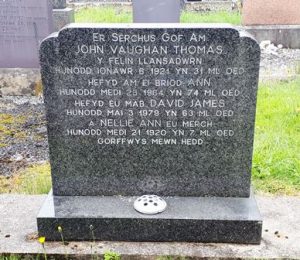
John Thomas Walters, Private, 30568, South Wales Borderers. Thomas was born in 1879, the son of William Walters and Anne Walters (nee Thomas), of Pendref Uchaf, Llanfihangel-ar-Arth. He was living at Park Villa, Llanfihangel-ar-Arth when on 2 October 1908 married Margaretta Felix of Glanduar Shop, Llanybydder. The couple then set up home together at Prospect House, Llanybydder, where their two sons were born. John enlisted at Llanybydder into the army, and upon being drafted to France in the summer of 1917 was posted to the 11th Battalion, South Wales Borderers. The battalion had been in France since December 1915, and was attached to 115 Brigade, 38th (Welsh) Division. The division was in the process of rebuilding following heavy losses suffered during the Third Battle of Ypres, and its epic assault on the Pilckem Ridge, when John arrived. The Division was then transferred to the Sailly-sur-la-Lys sector in September, and remained in the area over the winter before being moved to positions north of Albert, at Bouzincourt Ridge, at the end of March 1918, relieving the battered 2nd and 47th Divisions. In the meantime, however, the British army was reorganised, and every brigade lost an infantry battalion, which was then disbanded and its men posted to other units. The 11th SWB was disbanded in February 1918, seven officers and 150 men being transferred to the 10th SWB on 16 February, whilst detachments were also dispatched to join the 1st and 2nd SWB, with some 15 officers being posted to the former battalion and nine to the latter. The bulk of the battalion was kept together for some little time longer under the title of the 2nd Entrenching Battalion and remained in the Armentieres Sector when the 38th (Welsh) Division left to move to the Somme. The bulk of the fighting so far in 1918 had been on the Somme, following the launching of the German Operation Michael on 21 March, however their attention was now to switch further north. The German bombardment along the Lys front opened on the evening of 7 April, against the southern part of the Allied line between Armentières and Festubert, then at dawn on 9 April the German Sixth Army attacked with eight divisions, striking the Portuguese Second Division, launching the second phase of their spring offensive, Operation Georgette, along the Lys Valley. The Portuguese division was overrun and withdrew towards Éstaires, leaving the 55th (West Lancashire) Division outflanked, forcing it to withdraw, while the 40th (Bantam) Division, to the north of the Portuguese, was also overrun. The situation was desperate, so Sir Henry Horne ordered his reserve forward (the First King Edward’s Horse and the 11th Cyclist Battalion) to stem the German breakthrough, but these two units were also overwhelmed and on 10 April Armentieres was lost. The 2nd Entrenching Battalion was then called upon to join a hurriedly organised Composite Battalion in the XV Corps and was ordered forward to Merville Station Goods Yard to hold the bridges across the Lys at Merville. The men took up their positions on the morning of 11 April 1918, then at about 15.30 came under heavy attack. John was posted as missing during the terrible fighting which followed that day. It wasn’t until October 1918 that his widow Margaretta received news of his death on 11 April 1918. The 40-year-old is buried in Merville Communal Cemetery Extension, France. Both of his sons, William Edward Felix Walters, and Henry John George Walters, named their homes Merville in later life.
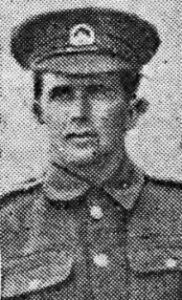
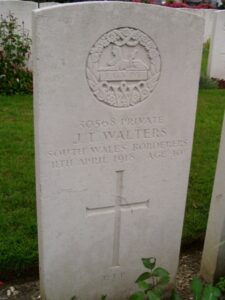
Daniel Williams. The Llanybydder war memorial shows the name of Daniel Williams, and that he lived at Neuadd Cottage and died aged 43. No man matching these details from Llanybydder can be traced, although a Daniel Williams resided at Neuadd Cottage and died on 3 February 1964; whilst another Daniel Williams had resided there and died on 30 December 1910?
World War Two, 1939-1945
Islwyn Alban, Gunner, 1138909, Royal Artillery. Islwyn was born on 28 February 1915, the son of Thomas Alban and Mary Alban (nee Thomas), of 5, Waterloo Street, Llanelli. His parents moved back to their native Llanybydder at sometime before the war, and Islwyn began work there as a carpenter. He married Elizabeth Jones, of Coedmor, Pencader, in 1942. Islwyn enlisted into the Royal Artillery and was posted to the 65th Field Regiment, Royal Artillery. The regiment had been in France in 1939 as part of the 44th Division of the BEF. The remnants of the 65th Field Regiment were among the thousands of British and French soldiers that were pulled off the beaches of Dunkirk during May and June, 1940. They were then sent to North Africa, and fought at the Battles of Alam Halfa and El Alamein, and were disbanded in North Africa after El Alamein. The 65th Field Regiment, RA went on to serve in Italy, during the Landings at Anzio, and Islwyn was killed in action during the Battle of Anzio on 22 May 1944, during the Allied breakout of the Beachhead. He was 29 years old, and he is buried in Beach Head War Cemetery, Anzio. Islwyn is not commemorated at Llanybydder, but at Pencader.
Ann Joan Davies, Aircraftwoman 1st Class, 2076919, Women’s Auxiliary Air Force. Ann was the daughter of Henry Davies and Rosie Mary Davies (nee Jones), of Blaenpant, Llanllwni. Ann enlisted into the Women’s Auxiliary Air Force, and was posted to 11 Balloon Centre at RAF Pucklechurch, in Gloucestershire. The base was under the command of RAF Filton and operated barrage balloons around the Severn Estuary and also covering the Bristol Aircraft Factory at Filton and Bristol Docks. Ann died on active service at Bristol on 15 August 1942. The remains of the 19-year-old were brought home and she was buried in Rhydybont Congregational Chapelyard.
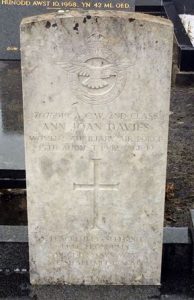
David Ronald Llewellyn Jones, Driver, T/198182, Royal Army Service Corps. David was born on 29 May 1912, the son of Llewelyn Jones and Mary Hannah Jones (nee Williams), of Llwynffynon, Llanybydder. David worked as a lorry driver prior to the war and married Rachel Anne Davies at Ammanford in 1933. As a skilled lorry driver, David enlisted into the Royal Army Service Corps. He served in France, landing at some time after D-Day. Little else is known of him, but David died during the final stages of the war in Europe on 4 April 1945. The 33-year-old was buried in Lille Southern Cemetery, France. His brother, Trevor, was killed in Holland in 1944.

Trevor Isaac Jones, MM, Lance Sergeant, 3970378, Welch Regiment. Trevor was born in Llanybydder in 1914, the son of Llewelyn Jones and Mary Hannah Jones (nee Williams), of Llwynffynon, Llanybydder. He married Edith Samuel in 1934 and the couple set up home at Nebo. Trevor enlisted into the Welch Regiment soon after the outbreak of war and was posted to the 1/5th Battalion, Welch Regiment. The battalion was the Glamorgan Territorial Army infantry battalion and was attached to the 160th Brigade, 53rd (Welsh) Division. The battalion was mobilised at the outbreak of war, when the Division moved to Northern Ireland to begin garrison duties. The Division then moved to Pembroke Dock, before moving again to the south of England, where it trained in readiness for the D-Day Landings. On 24 June 1944 the 5th Welch embarked at Newhaven and sailed for Normandy, landing on Jig Beach at La Riviere near Ver Sur Mer and the 5th Welch assembled near the village of Subles by 28 June, resting on the following day before entering the battle for Normandy. The 5th Welch moved forward to Bronay on 30 June 1944, taking up positions facing the Germans. The Division then took part in heavy fighting over the coming weeks, as part of the effort to break-out of the Normandy beach-head, seeing heavy fighting at Évrecy, before starting the epic advance through Northern France into Belgium and Holland. On 16 August 1944, Trevor carried out an act of gallantry which earned him the award of the Military Medal. The citation reads: ‘On Aug 16th 1944, near BAFOUR, Sjt JONES was commanding No. 10 Pl of ‘B’ Company which was the left forward Coy in a Bn attack on objectives near the railway. His Co had to cross open cornfields under fire from MGs at close range and also an 88mm gun. Considerable casualties were caused by these and in addition to booby traps set in the corn. Undeterred, he led on his diminished platoon until he encountered enemy positions at close quarters. He then ran on alone and killed or wounded all the occupants of at least two Spandau and rifle posts. His action enabled the advance of the remainder of his Coy to continue but again on encountering enemy posts on the objective at close quarters Sjt JONEs repeated his performance alone, silencing another post. Throughout the battle he continued to set a splendid example of courage and leadership and there is no doubt that his actions were in a great measure responsible for placing the Company on its objective.’ Trevor had been recommended by his CO, Lieutenant-Colonel Gibson, and the award was signed off by Bernard Law Montgomery. On 15 September the Division forced the crossing of the Junction Canal North of Lommel, and continued to push westwards towards Elst, between Nijmegen and Arnhem, during Operation Market Garden. Trevor was killed in action during an attack near Casteren on 22 September 1944. The 30-year-old is buried in Valkenswaard War Cemetery, Netherlands. His brother, David, died in Lille in 1945.
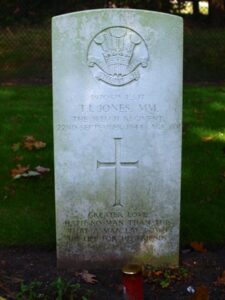
Harold Anthony Murray, Battery Quartermaster Sergeant, 1396426, Royal Horse Artillery. Harold was born at Romford on 9 July 1905, the son of Percy Oswald Murray and Sarah Ann (Nancy) Murray (nee Jordan). He married Elizabeth Anne Evans at Hendon in 1931. The couple resided at 55, Cheyne Walk, Hendon, but prior to the war had moved to Bodeinon, Llanybydder, the home of Elizabeth’s father, John Bowen Evans. Harold enlisted into the Honourable Artillery Company, and was posted to the 11th (Honourable Artillery Company) Regiment, Royal Horse Artillery. The regiment, equipped with 25-pounder guns was sent to North Africa in December 1941 to take part in the Western Desert campaign. Harold was taken prisoner by the Italians early in the campaign, and was among several hundred POW’s who were embarked onto the Italian Ship Ariosto, which set sail for Italy from North Africa. On 15 February 1942, Ariosto was torpedoed and sunk by the Royal Naval Submarine P-38, and 138 POW’s were lost. Harold was among the dead. The 36-year-old has no known grave and is commemorated on the Alamein Memorial, Egypt. Harold does not seem to be commemorated locally, although his widow Elizabeth continued to live at Llanybydder until her death in 1979.
William Lloyd Rees, Rifleman, 6916543, Rifle Brigade. William was born in 1917, the son of David Rees and Mary Rees (nee Jones) of Myrddin House, Llanybydder. He enlisted into the army and was posted to the 7th Battalion, Rifle Brigade. The battalion was formed by re-naming the 1st Battalion, London Rifle Brigade in January 1941, becoming part of the 23rd Armoured Brigade, 8th Armoured Division. The division was sent to Egypt in July 1942 and played a role in the First Battle of El Alamein. On the following month, the 7th Rifle Brigade became posted to the 7th Motor Brigade, 1st Armoured Division, later transferring to the independent 9th Armoured Brigade and finally to the 61st Lorried Infantry Brigade for the Italian Campaign from May 1944 onwards. William saw heavy fighting with the division during its drive through Italy, taking part in the fighting at the Liri Valley, Arezzo, the advance to Florence, the attacks on the Gothic Line and the Argenta Gap. William was taking part in the fighting on the Italian Front when he was killed in action on 10 June 1944. The 27-year-old was originally buried on the battlefield near Poggio Mirteto as an unknown soldier. His grave was located in February 1945 and was identified, before being re-interred in Rome War Cemetery, Italy. The photograph of William is courtesy of Gary Rees.
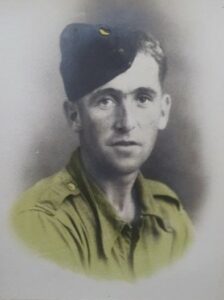
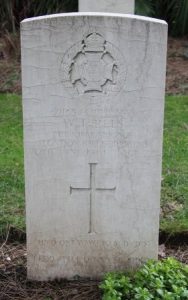
Thomas Arthur Thomas, Corporal, Home Guard. Thomas was born on 21 August 1907. He married Margaret Gwyneth Jones in 1937 and the couple initially set up home at Glanafon, Llanybydder. Thomas was a motor lorry driver prior to the war, but enlisted into the Home Guard and was posted to the Llanwenog Platoon. He died at Aberystwyth Infirmary on 25 June 1944, following an accident. The remains of the 34-year-old were brought home and he was buried in Llanwenog Cemetery four days later. By now his widow, Margaret, was residing at Tegfan, Llanwenog. Thomas is not commemorated as a casualty by the CWGC and is not commemorated on the Llanybydder war memorial.
Thomas Arthur Thomas, Sergeant, 625095, Royal Air Force. Thomas was born in 1920, the son of Evan Tom Thomas and Elizabeth Thomas, of Y Fro, Llanybydder. He left home as a young man to enlist into the Royal Air Force and after training as a Wireless Operator/ Air Gunner was posted to 59 Squadron, Royal Air Force, which was based at RAF Odiham, Hants. On 16 June 1940, during the withdrawal of the BEF to the Channel Coast, Thomas took off from Odiham aboard a Bristol Blenheim IV, Serial R3817, on a reconnaissance flight to the Le Mans-Rennes area. The Blenheim was intercepted by a German fighter over Nonancourt and was shot down, with the loss of all three of her crew. Thomas was just 20 years old when he was killed that day and is buried alongside his fellow crewmen in Dreux Communal Cemetery, France.